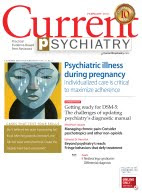skip to main |
skip to sidebar
Daniel J. Smith, MD, MRCPsych
Clinical senior lecturer in psychiatry, Cardiff University School of Medicine, Cardiff, UK
At least 25% and possibly up to 50% of patients with recurrent major depressive disorder (MDD) have features of mild hypomania (the “soft end” of the bipolar spectrum) and might be better conceptualized as suffering from a broadly defined bipolar (BP) II disorder. The challenge is to differentiate MDD from BP II so that we make treatment decisions—such as antidepressants vs mood stabilizers—shown to improve the long-term course of patients’ depressive symptoms.
Diagnosis of BP II often is not straightforward and unfortunately may be delayed several years after patients first present for evaluation. To help clinicians make correct diagnostic decisions, this article:
- describes diagnostic criteria outside of DSM-IV-TR that can assist in identifying BP II disorder
- identifies subgroups of recurrently depressed patients whose primary disorder is more likely to be bipolar than unipolar
- provides a screening tool validated for identifying “soft” bipolarity
- offers a pragmatic clinical perspective on the treatment of BP II disorder.
Read full text (free access)Listen to Dr. Smith offer tips on differentiating bipolar II and borderline personality disorderComment on this articleEmail the editor
Charles Scott, MD
Professor of clinical psychiatry, Chief, division of psychiatry and the law, Department of psychiatry and behavioral sciences, University of California, Davis School of Medicine, Sacramento, CA
Phillip J. Resnick, MD
Professor of psychiatry, Director, division of forensic psychiatry, Case Western Reserve University, Cleveland, OH
Police take Ms. L, age 23, to the emergency room (ER) after her fiancé called them. He told the police that after a “night of drinking” they argued about a girl he had flirted with. Ms. L took out a loaded gun and threatened to shoot herself. She eventually handed the gun over to the police.
In the ER, Ms. L’s blood alcohol level is 0.20%. She tells the admitting emergency room nurse, “I would never hurt myself. I drank too much and was acting stupid. I just want to go home and sleep it off. I promise not to harm myself.” Emergency room staff observe Ms. L smile and giggle while waiting for a psychiatric evaluation.
What would you do? Hospitalize Ms. L for safety, or accept her promise not to hurt herself and send her home? What criteria would you use?
Knowing how to assess patients such as Ms. L is an essential psychiatric skill, whether or not you trained in forensic psychiatry. This article includes case reports that illustrate techniques for evaluating patients who may harbor suicidal or homicidal thoughts.Read full text (free access)Comment on this articleEmail the editor
Jean A. Frazier, MD
Robert M. and Shirley S. Siff Chair and professor of psychiatry and pediatrics, and vice chair and director, division of child and adolescent psychiatry, University of Massachusetts Medical School, Worcester, MA
Robert A. Kowatch, MD, PhD
Section Editor for Current Psychiatry and professor of psychiatry and pediatrics, Cincinnati Children’s Hospital Medical Center, Cincinnati, OH.
Jean A. Frazier, MD was 1 of 4 principal investigators in the Treatment of Early-Onset Schizophrenia Spectrum Disorders (TEOSS) study, a randomized, double-blind, multisite trial funded by the National Institute of Mental Health. The study, published in November 2008, compared the efficacy and tolerability of 3 antipsychotics—olanzapine, risperidone, and molindone—in pediatric patients with schizophrenia or schizoaffective disorder.
Dr. Frazier discusses the unexpected findings of the TEOSS trial with Current Psychiatry Section Editor Robert A. Kowatch, MD, PhD. Based on the trial findings and her experience, she tells how she makes decisions when prescribing antipsychotics for children and adolescents with schizophrenia and related disorders.Read full text (free access)Comment on this articleEmail the editor

Henry A. Nasrallah, MD
Editor-in-Chief Change is coming for continuing medical education (CME). A cloud of conflict of interest has shrouded any person or activity that receives pharmaceutical funding, including the venerable institution of CME. This is a big deal because all health practitioners rely on CME programs to meet requirements for license renewal and to keep up with medical advances.
Attitudes about commercial support of CME have changed, with some organizations calling for elimination of all industry funding. Pressure to strip commercial support from CME is equivalent to draining blood from a living organism; it can have dire consequences if done precipitously.
Read full text (free access)
Comment on this article
Email the editor


